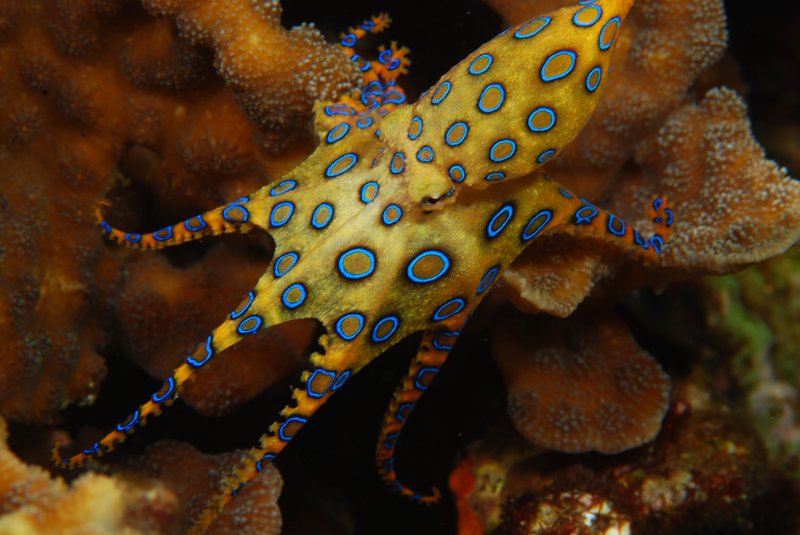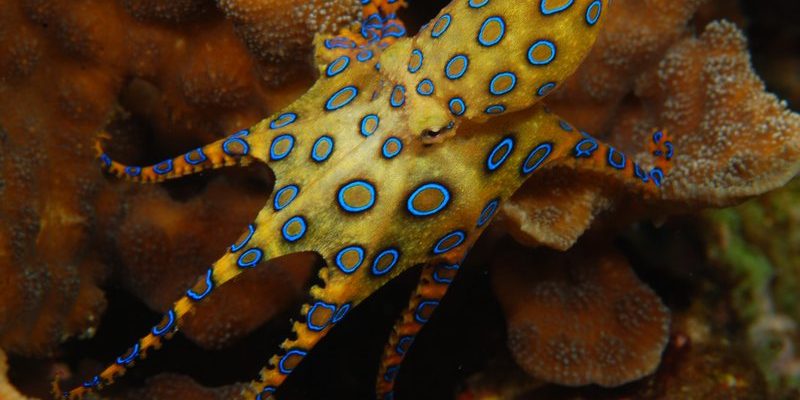
Now, you might be wondering, can we actually interact safely with this fascinating creature? The short answer is yes, but with a lot of caution. While they are not aggressive by nature, blue-ringed octopuses bite when provoked or handled, and their venom is extremely potent. So, let’s explore how to appreciate these incredible creatures without getting ourselves into deep waters.
Understanding the Blue-Ringed Octopus
To start off, it’s essential to know what makes the blue-ringed octopus so unique. There are four recognized species of blue-ringed octopuses, each one smaller than your average grapefruit, typically no longer than about 5 to 8 inches. Their bodies are soft and squishy, making them super adaptable at hiding in crevices and small spaces, usually among coral reefs and rocky shorelines.
Their most striking feature, the blue rings, are a warning signal. When these octopuses feel threatened, the blue rings become brilliantly visible. This is a natural defense mechanism, designed to scare off predators. Here’s the thing: while they may look harmless, their venom contains a toxin called *tetrodotoxin*, which can cause paralysis and even death. The octopus is like a cute yet dangerous little ninja, mastering the fine balance between beauty and lethal capability.
Will They Attack Humans?
First off, the blue-ringed octopus is not out to get you. They’re shy creatures that prefer to blend into their environment rather than confront threats. Most bites occur when humans accidentally step on them or handle them out of curiosity. Imagine being in a crowded room—while you might be okay just standing there, you wouldn’t appreciate someone poking you unexpectedly.
Moreover, bites are incredibly rare. In fact, there have been only a handful of reported incidents each year. This doesn’t mean you should let your guard down, though. If you see one, it’s best to admire from a distance. If you’re snorkeling or diving, keep an eye on where you’re stepping and don’t reach into small rock formations or crevices.
Safe Interaction Guidelines
If you find yourself in a situation where you’d like to interact with a blue-ringed octopus, there are some important guidelines to keep in mind. Think of these as the unwritten rules of the ocean:
- Maintain a safe distance: This can’t be stressed enough. Observing from a distance not only protects you but also allows the octopus to feel safe.
- Don’t poke or prod: If you feel the urge to touch, resist! It’s best to let them be.
- Avoid sudden movements: Quick movements can startle them, leading to an instinctual bite.
- Educate yourself: The more you know about these creatures, the more you’ll appreciate their beauty and understand their behavior.
Following these guidelines can help ensure that both you and the blue-ringed octopus remain safe. Remember, it’s all about respect—respect for their space and for their inherent nature.
What To Do If You Get Bitten
In the unfortunate event that you do get bitten by a blue-ringed octopus, it’s vital to act quickly. Here’s what you should do:
1. Stay Calm: As difficult as it may be, try to keep calm. Panic can worsen the situation.
2. Call for Help: Get emergency medical assistance immediately. Time is of the essence.
3. Avoid Exertion: Limit movement to conserve energy.
4. Keep Your Airway Open: If you begin to experience symptoms like difficulty breathing, try to stay sitting or lying down, keeping your airway clear.
What you’re dealing with is serious, as the venom can lead to paralysis. The good news? Medical professionals know how to handle this and effective treatments are available.
Exploring Alternatives for Encounters
If you’re fascinated by blue-ringed octopuses but wary about direct interaction, there are plenty of alternatives to consider. Many aquariums offer safe viewing experiences, where you can watch these creatures under controlled conditions. You can also engage in citizen science programs, contributing to research while learning more about marine habitats.
Another option is virtual reality experiences, which can let you explore underwater environments without the risk of getting bitten. These platforms often provide detailed information about marine life, including the blue-ringed octopus, allowing you to appreciate their beauty from the comfort of your home.
The blue-ringed octopus is a fascinating example of nature’s artistry, combining beauty and danger in one small package. While humans can interact safely with these incredible creatures, it’s crucial to do so with care and respect. Observing them from a distance and abiding by safety guidelines can help ensure both you and the octopus remain unharmed.
At the end of the day, it all comes down to appreciation. Whether you’re admiring their vibrant colors from a distance or learning about them through documentaries or exhibits, there’s so much to value about the blue-ringed octopus. And remember, the ocean is their home—let’s not intrude unnecessarily.

